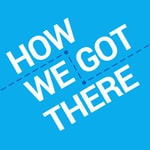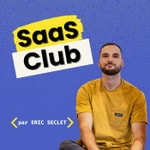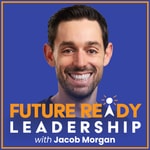How We Got There – Details, episodes & analysis
Podcast details
Technical and general information from the podcast's RSS feed.

How We Got There
Mike Davis
Frequency: 1 episode/40d. Total Eps: 43

Recent rankings
Latest chart positions across Apple Podcasts and Spotify rankings.
Apple Podcasts
🇨🇦 Canada - marketing
23/07/2025#95🇨🇦 Canada - marketing
22/07/2025#45
Spotify
No recent rankings available
Shared links between episodes and podcasts
Links found in episode descriptions and other podcasts that share them.
See all- https://www.eosworldwide.com/
211 shares
- https://www.activecampaign.com/
160 shares
- https://www.ringcentral.com/
32 shares
RSS feed quality and score
Technical evaluation of the podcast's RSS feed quality and structure.
See allScore global : 43%
Publication history
Monthly episode publishing history over the past years.
How We Got There: Blakely Graham, board advisor to ISVs and Founder and former CEO of TaskRay
Season 3 · Episode 3
lundi 14 juillet 2025 • Duration 45:01
I am joined by Blakely Graham, who is a board advisor to Left Main REI, host of the Not All Business Podcast, Founder and former CEO of TaskRay. This one was a long time coming. On a personal note, my time at TaskRay was some of my most formative. I found a balance while there between my previous experience of excellence with true work life balance and a focus on values that stays with me. I am so grateful that Blakely and team took a chance in hiring me for a role that I was almost kind of qualified for and her friendship since then.
I'll do my best to summarize this episode, but it's more than worth a listen because I don't have enough characters to summarize it all.
Blakely's Salesforce journey starts in 2001 and spans a ton of roles and experiences. We dig deep into her experience founding TaskRay 15 years ago in 2010 as Bracket Labs as one of the early ISVs on the AppExchange where VCs told her that her business was not investable and it was "a lifestyle business" at best because the Salesforce ecosystem was too small. She grew it in spite of that and by the time they sold the business, they were getting endless inbound interest.
We talk about culture and values and why they were so important to her and the team at TaskRay. One of the core values was Connection that was the inspiration for Project Connection where the founders and I went to 5 cities and sat across the table from over 20 customers without an agenda outside of learning how our customers used the app. It drove focus for years to come that had nearly endless valuable outcomes like clarity of product roadmap, dramatically reduced churn, drove brand/marketing strategy, and much more.
She shares how founder conflict snuck up on her with Eric Wu as well as how they (eventually) resolved it.
As we switched gears to talk about gtm, Blakely shares how TaskRay evolved from the primary source of leads being the AppExchange with mostly SMB customers to more enterprise selling with content strategies, partnership motions, events, and more knobs we turned. The lesson is you are going to try stuff - some will work, some won't but you have to innovate and measure.
We talk about how to select and what you can expect from an advisor. At TaskRay, we rolled an advisor program out modeled after a talk Blakely listened to from Andy Wilson, founder of Logikcull. Shoutout to Phil Stern who was my sales leader advisor at TaskRay who helped me avoid many mistakes.
Show notes:
- Jolene Chan's LinkedIn where she was talking about a personal board of directors: https://www.linkedin.com/in/jolenec/
- Not All Business podcast with Heather Cooper: https://www.linkedin.com/company/not-all-business/
- Podcast with Andy Wilson from Logikcull where he discusses his advisor program that we modeled TaskRay's after: it starts at 14:05 and lasts 4 minutes starts at 14:05 and lasts 4 minutes -https://podcasts.apple.com/us/podcast/saastr-236-logikcull-ceo-andy-wilson-on-%240-to-%2410m/id1089973241?i=1000439148009
This episode is brought to you by Invisory. Invisory is designed to meet you where you are: in your cloud marketplace journey through a strong go-to-market strategy that helps drive prospect and co-sell opportunities with Salesforce, AWS, Microsoft, and Google.
How We Got There: Heather Cooper, COO at Baker Law Group and former CEO of Cloud Coach
Season 3 · Episode 2
vendredi 20 juin 2025 • Duration 30:04
I am joined by Heather Cooper, the COO at Baker Law Group and the former CEO at Cloud Coach. Heather and I didn't know each other when we competed against each other (TaskRay and Cloud Coach) but have gotten to know each other since, which has been really fun. She is starting a podcast with one of my favorite work people, Blakely Graham, that will launch later this year.
While Heather was at Cloud Coach, they found a great talent pipeline by running an internship program recruiting heavily from the local university near their HQ, Colorado State in Fort Collins, CO. She shares lessons learned regarding sizing of that program.
We talk about her experience working with Tequity advisors, who are a sell-side advisory firm, helped her navigate leading the process where Cloud Coach exited to private equity and how engaging early, way before they were ready to sell, was important along the way.
Even though Heather is A lawyer, she isn't YOUR lawyer. With that in mind, her and I talk through some important concepts for every ISV to consider and hold the line around key contract terms like termination for convenience, multi-year deals, and the importance of educating the buyer on how security works with the Salesforce platform.
This episode is brought to you by Invisory. Invisory is designed to meet you where you are: in your cloud marketplace journey through a strong go-to-market strategy that helps drive prospect and co-sell opportunities with Salesforce, AWS, Microsoft, and Google.
How We Got There: Mike Getchis, former VP of Sales at Zenkraft and now Partner Solutions Engineer at Bringg
Season 2 · Episode 13
vendredi 4 novembre 2022 • Duration 27:34
In today’s episode of How We Got There, I talk with Mike Getchis, who was the VP of Sales at Zenkraft. They were acquired by Brinng earlier this year and he is now Partner Solutions Engineer. Mike was at the helm of Zenkraft’s sales organization which bootstrapped their way to a strategic exit but started his Salesforce journey with hands on keyboard.
Zenkraft’s top gtm strategies included working with SIs, Salesforce, and other ISVs. They found that their AppExchange listing was the starting point for the SI community, so focused on giving them partner-ready materials and a quick way to get them in touch with technical resources. The access to technical resources is an important component to any SI partner program that is often overlooked and mirrors my experience at Conga.
Mike shares his experience participating in Salesforce Accelerate and how it improved their positioning and execution of aligning with SEs and AEs. Their SDO page is a high water mark for the ecosystem in terms of enabling the Salesforce SEs to demo their solution. And when they close a deal, they are intentional about a bottoms up strategy to share the win with their peers in a lean way. Zenkraft’s app is horizontal so they have a challenge of focus which I hear from a lot of ISVs.
In regards to their AppExchange listing, he speaks to the value from an Account Management perspective of knowing when customers refresh their sandbox and how Test Drive can help drive leads. His secret sauce to having over 300 5-star reviews? Asking them. After a successful implementation or great support experience, their whole team asks them to write a review.
Here’s a closer look at the episode:
- 1:00 About ZenKraft and How Mike joined the ecosystem
- 3:00 Salesforce hands on keyboard, what did that teach you about selling in the ecosystem?
- 4:00 What was the best go to market program that you created there?
- 9:10 How did you prioritize with a small team that was Bootstrap?
- 13:20 For folks that haven’t gone through an accelerated program, what would you say to them as they consider applying for a future cohort?
- 15:44 The importance of the AppExchange
- 17:28 Tips on improving reviews on the AppExchange
- 18:42 Through your journey at Zenkraft, what are you most proud of?
Resources:
- AppExchange Listing: https://appexchange.salesforce.com/appxListingDetail?listingId=a0N3A00000DvLFvUAN
- Website: https://www.bringg.com/
- Mike’s LinkedIn: https://www.linkedin.com/in/mike-getchis-57075891/
- Salesforce Accelerate: https://www.salesforce.com/campaign/accelerate/
- Zenkraft’s Demo Kit: https://zenkraft.com/demokit/retail
This episode is brought to you by ISVapp. ISVapp is used by leading Salesforce ISVs and OEMs as the central toolbox to reduce churn, increase renewals, identify upsell potential, and close more deals. ISVapp is the only plug & play solution for the AppExchange AppAnalytics API and provides deep product insights. The set up is easy and takes less than 5 minutes. Visit isvapp.com to learn how you can take advantage of usage data in your app today.
How We Got There: Bethany Blackwell, VP at Carahsoft
Season 2 · Episode 12
mardi 13 septembre 2022 • Duration 35:12
In today’s episode of How We Got There, I talk with Bethany Blackwell, who is a VP at Carahsoft. Bethany runs the Salesforce channel for Carahsoft, which includes Salesforce, Slack, Mulesoft, Tableau, ISVs, and SIs. Carahsoft has worked with Salesforce for the past 15 years as a Value-Added Reseller and got there start on the GSA schedule to help Salesforce sell to the public sector here in the US. They help with sales, marketing, and contracting for Salesforce and it’s partners to federal, state, and local government organizations.
If you have public sector demand for your application that includes interest from a customer, it’s a good time to reach out to Carahsoft who will get you set up on the correct contract vehicle. This will expedite the purchasing process, sometimes even avoiding the need to take it to RFP. The earlier you call them the better, even before pricing is discussed. As your public sector gtm becomes more intentional with at least one FTE focused on this industry, Carahsoft will work with partners add value to your sales and marketing efforts. Top examples are Nintex, Copado, Ownbackup, and many more.
Recent legislation in the US has caused even more opportunity for the Salesforce platform and ISV partners to help deliver value to it’s citizens. During the pandemic, Bethany recalls all of the amazing solutions that the ecosystem helped to create with 20+ states using the Salesforce platform for contact tracing and vaccine rollouts.
We discuss FedRamp, which is a set of standards put in place for security standards for software offerings. The program is great for buyers but takes significant money and time for an ISV but is required for companies looking to go “all-in” for public sector. A common misconception for ISVs that are native to Salesforce is that because they are built on the Salesforce platform and they are FedRamp/SOC 2 Type 2 certified, you as an ISV inherit that. It’s true it makes it easier but it involves (much more) than just that.
If you’re interested in exploring this channel, reach out to them at salesforce@carahsoft.com for an introductory meeting. A tip for your conversations is to ask them how they purchase today, do they leverage Carahsoft? Carahsoft can help partners with their gtm approach for public sector!
Here’s a closer look at the episode:
- ’0:01:19 What role does Salesforce have in the ecosystem that they lived in?
- ’0:01:44 What Carahsoft does for salesforce and for the broader ecosystem?
- ’0:03:22 How should they think about Carahsoft and how you can help?
- ’0:06:37 What’s the best strategy on how to go to market in this ecosystem?
- ’0:06:57 How does your team work with the Salesforce AEs in the public sector?
- ’0:10:20 Who do you work with today, and some lessons learned?
- ’0:10:26 What are some mistakes folks can avoid?
- ’0:18:33 What’s a mistake to avoid for folks starting to dip their toe into federal or state?
- ’0:20:22 What the process for an ISV would look like? How long does it takes?
- ’0:25:40 What are you most proud of from your work at Carahsoft?
- ’0:26:59 What’s your team working on, in. regards to the Salesforce ecosystem?
Resources:
- E-maill: salesforce@carahsoft.com
- Website: https://www.carahsoft.com/
- Bethany’s LinkedIn: https://www.linkedin.com/in/bethany-blackwell-8a3b5016/
How We Got There: Doug Landis, Growth Partner at Emergence Capital
Season 2 · Episode 11
lundi 12 septembre 2022 • Duration 38:56
In today’s episode of How We Got There (which was recorded earlier this year, before the downturn), I talk with Doug Landis, who is a Growth Partner at Emergence Capital. Doug spent some time at Salesforce and Box before moving into his current role in helping Emergence’s portfolio companies with go-to-market assistance. He was working in the early days of sales enablement and now recommends hiring rev ops and sales enablement roles earlier than you think, even at Series A, to drive productivity in the sales organization.
Emergence Capital is a venture capital firm that invests in B2B Enterprise SaaS businesses for their Series A and B funding rounds. They’ve invested in Veeva, Steelbrick, Box, and many more household names in the Salesforce ecosystem.
The biggest challenge every early stage company will face is pipeline and that can be helped by hiring Marketing leadership before sales leadership, because sales professionals won’t enjoy being full cycle for very long. His message to early stage founders is to become obsessed with pipeline. In deals over $10k, there are normally 8-10 people in the buying decision even if there is a single major person that your solution will help. A good benchmark for any AE is they should be generating ~20% of their own pipeline.
Key metrics to look at are by account, how many contacts are on each account and then dive deeper into touches by contact to know depth of engagement in a given opportunity. Looking at conversion rates can help you zero in on gtm priorities to work on.
Technical founders make mistakes by hiring a salesperson too early because you need to learn how to sell early on. A good target is for you to sell the first $1M in ARR and collect insane insights along the way for your product while capturing referrals. Hiring customer success people early on the other hand is wise because your first few customers need to be successful, you can’t afford to churn your first customers (unless you learn they aren’t a good fit for where you’re going).
Before starting the process of fundraising, you need to know your data inside and out beyond your pitch deck that includes a strong “why”. Include customer stories to help tell your story. It’s important to make a thoughtful list of potential investors that will be good long-term partners with you who will offer you the right level of engagement to guide you on the things you might be missing.
For the ecosystem specific advice, he shares a word of caution for ISVs in getting Salesforce Ventures to participate in your round. Doug’s view is when you take Salesforce Ventures money…..and it’s cause for pause. If they build something like what you’re offering, you could be in big trouble. He share the story of Steelbrick (Emergence was the lead investor here) and Apttus and how Salesforce leveraged their relationship to strong arm Steelbrick during the acquisition.
Here’s a closer look at the episode:
1:37 How did you find your way into the ecosystem?
5:13 Sales enablement
9:55 Who is Emergence and what’s your role there?
14:16 What are some elements that make a great go to market approach in a series A or B company?
22:07 What’s the biggest mistake you see technical founders make before they hire professional salespeople?
25:53 So founders in the ecosystem, if they’re considering raising institutional capital, what should they know before starting the process?
34:15 What are you most proud of in your career?
36:10 The final three
Doug’s Linkedin: https://www.linkedin.com/in/douglandis/
Emergence Capital’s Website: https://www.emcap.com/
Emergence Capital’s Linkedin: https://www.linkedin.com/company/emergence-capital-partners/
How We Got There: Jon Schultz, Director of ISV Sales at Salesforce
Season 2 · Episode 10
jeudi 11 août 2022 • Duration 33:28
In today’s episode of How We Got There (which was recorded earlier this year), I talk with Jon Schultz, who is a Director of ISV Sales at Salesforce. Jon has spent his career in partnerships, including the last 6 years at Salesforce. He got a PAM role at Salesforce after moving with his now wife across the country without a job! His team works with horizontal ISV partners who are high growth partners and/or partners who have been in the ecosystem for a long time. His team serves native, high growth, and enterprise partners in the ecosystem.
Jon shares the differences in ISV team alignment from partners just starting out through Summit level partners and how his team works with their partners to align around gtm & technology strategies. I ask Jon about the WIIFM for your PAM as an ISV/OEM and how his team is measured. They are measured based on revenue share from their partners so there is a direct alignment between a partner’s revenue growth for incentive compensation. Beyond revenue, he looks to his PAMs to help them change their business with an example being opening offices overseas from their HQ.
And Mike said this, not Jon…..incentives drive behavior. If you close a big deal at the end of a quarter, submit that order and share it with their PAM as they are aligned with that success. Jon adds to that concept with calling out that as soon as the order is submitted, his team can now share this win story with the direct team via win tiles and slack posts.
From a partnership strategy, expect your PAM to help amplify your message once things get rolling but don’t start by asking them “where are my leads?“. I put Jon on the spot around partners to watch who are doing the right things and although he didn’t share a specific partner with me but did talk about how his counterpart worked with him to analyze data around the value of the Salesforce partnership, showing Salesforce connected customers are worth 1.5x revenue. This lead the leadership team to grow the Salesforce partner team headcount at the ISV to drive incremental capacity to align with the direct teams at Salesforce. From an AppExchange listing point of view, take a look at Accounting Seed, TaskRay and Prolifiq as examples of great from a content perspective including usage of Test Drive for leads.
His team will always lean in when their partners lean in. His advice for all ISVs is to spend time to think through what the goals are for the Salesforce partnership as it relates to your organization.
We talk about Salesforce SDO and Salesforce IDO integration and the right time to consider building an extension package that Salesforce SEs can demo of your solution as part of their demonstrations. Make sure you know your message, your market, and what features align with what is hitting home with customers and Salesforce SEs/AEs. Starting it too early can waste some cycles, so look for signals like SEs asking you to help them install your app into their SDO or IDO.
Here’s a closer look at the episode:
- 1:00 How did you find your way into the ecosystem?
- 3:15 What types of ISVs your team serves?
- 4:50 What are some of the nuances that you see?
- 7:30. ISV PAMs on your team, what’s important to them, how are they measured?
- 11:30 what are some realistic asks that ISVs and OEM should be making of their PAMs
- 14:10 Can you share some great app exchange apps, listings or partners to replicate?
- 20:00 What is the right time that an ISV should start to think about SDO or IDO integration?
- 26:00 What are you most proud of from your time with the team?
- 27:30 What do you think every ISV should do this month?
- 29:30 The Final Three
Resources:
How We Got There: Ari Treuhaft, COO of Litify
Season 2 · Episode 9
jeudi 21 juillet 2022 • Duration 23:39
In today’s episode of How We Got There (which was recorded earlier this year), I talk with Ari Treuhaft, who is the COO of Litify.. Apologies for the audio quality but the conversation was too good not to share! He spent time at a law firm building an operating system for law firms on Salesforce and from there, Litify was born. They offer vertical SaaS for legal organizations, who think of themselves as unique and specialized organizations who need to build custom solutions. Litify has raised a series A pre-pandemic and now has over 200 employees and over 300 customers.
Litify is both an ISV and an OEM partner for Salesforce. Ari shares why being both makes sense for their business to align with buyers preferences in order to reduce go-to-market friction. They’ve found success in co-selling with Salesforce with OEM customers where the Salesforce sales teams was subsequently able to sell additional products, like Sandboxes and Marketing Cloud. And when a customer already has a footprint with Salesforce, they go the ISVforce route.
He talks about how he thinks about vertical SaaS and what they’ve learned from the likes of nCino and Veeva. One of the key learnings was around how to approach services internally and through SIs. Ari shares how they chose partners to work with in the SI realm and how you have to cut through a lot of noise in order to find the great ones. Align around values and mutual skin in the game….get into the single digits with target partners if you’re just getting started to go deep vs. going wide with efforts around enablement and training for your partners. As an ISV/OEM, you need to invest in these relationships.
Ari takes pride in providing a solution on the Salesforce platform in an underserved industry. On the flip side, he acknowledges that building out an internal Services team resulted in successful sales but a backlog of customers who weren’t getting live. They actually called up customers and shared candidly that they had to wait for kickoff for X months while they invested in their SI partner program training.
From a lead source perspective, for OEM leads they come from internal BD efforts and their SI partners. On the ISVforce side of the world, it is mainly the Salesforce AE/SE/RVP referrals. Ari shares some details about their SI partner referral program and how they share revenue with them in addition to having them perform the services. Across the board, focus on things that are working and do more of them. As you work to figure out what gtm channels are right for you, make sure you only run as many experiments as you can successfully measure. Once you start to see success in any of the experiments in the numbers, do more of it and maybe even drop the other active experiments.
Here’s a closer look at the episode:
- 0:16 How Ari found his way into the ecosystem?
- 3:36 Litify is both an ISVForce and an OEM? Why did they decide to go both paths?
- 6:20 As an OEM what have you learned from some of the other large OEMs out there?
- 8:02 What have been some of your learnings to share around that SI program?
- 10:24 You just need to find a handful that are really high quality!
- 13:55 What are good go to market examples?
- 12:21 What's been the biggest mistake along the way?
- 15:24 What’s been your top producing leads source for Litify?
- 16:16 Incentives program for referring business.
- 17:42 Experience with Tiger Capital
- 20:34 Program’s that provide Insight on tracking success?
How We Got There: Stony Grunow, Co-Founder at Breadwinner & Co-Founder/CTO at Salesbolt
Season 2 · Episode 8
mardi 21 juin 2022 • Duration 28:09
Stony Grunow is a Co-Founder of Breadwinner and Co-Founder/CTO of Salesbolt. He shares how he got started in the ecosystem and how he solved a problem he was experiencing with Breadwinner - integrating Salesforce and online accounting platforms. On the Salesbolt side, they are solving the problem of customer contact data getting out of date in CRM by reaching out to LinkedIn to get the latest and greatest into Salesforce.
Stony shared about his first sale as Breadwinner as an English major who stumbled into technology. They didn’t build a way for customers to actually pay for the service (!) so they eventually sent an email that their “free trial” was ending….and many paid! As a founder without a background in sales, he is a delight to talk to about all of the things they’ve figured out along the way. Stony shares how they leveraged creating blog posts with intention to rank on the first page of Google for Salesforce and Xero integration.
Stony talks through how important focus was early and how their focus helped them make their decision around bootstrapping the Breadwinner business. He shares his biggest mistake being “Snow Goose”, a product they built for charities in England. The customers all wanted it, but none of them wanted to/were able to pay for it.
We weaved into talking out my dog, Mellow who was a Houston street dog before finding his way to our couch. #WhoRescuedWho anyway…back to Stony!
Here’s a closer look at the episode:
- 00:00 Introduction
- 00:13 How did Stony start on Salesforce?
- 01:35 What’s Breadwinner and its relationship with SalesBolt?
- 04:10 How did Breadwinner find its first customers?
- 05:47 What’s the best program that was created?
- 08:28 Was there any “aha” moment?
- 09:50 What’s the thing you are most proud of from building Breadwinner?
- 11:29 Analyzing the customers
- 15:14 Talking about lead sources and how they work in this business
- 19:55 Talking about how referrals work
- 23:49 Talking about the market perspective
Resources:
- Website: https://breadwinner.com/
- Website: https://salesbolt.com/
- Twitter: https://twitter.com/breadwinner
- Linkedin: https://www.linkedin.com/company/breadwinner
- Youtube: https://www.youtube.com/channel/UCtKwGq3fIQ2cR0idP9gxi5g
- David Skok For Entrepreneurs: https://www.forentrepreneurs.com/
- Jason Lemkin: https://www.saastr.com/smb-sales-reps-how-low-can-you-and-your-acv-go/
This episode is brought to you by ISVapp. ISVapp is used by leading Salesforce ISVs and OEMs as the central toolbox to reduce churn, increase renewals, identify upsell potential, and close more deals. ISVapp is the only plug & play solution for the AppExchange AppAnalytics API and provides deep product insights. The set up is easy and takes less than 5 minutes. Visit isvapp.com to learn how you can take advantage of usage data in your app today.
How We Got There: Brooke Daniels, Director at Salesforce Ventures
Season 2 · Episode 7
dimanche 12 juin 2022 • Duration 25:33
Brooke Daniels who is a Director at Salesforce Ventures. She spent years using Salesforce before joining the core team and working on the Mulesoft acquisition integration. In her role, she is the go-to-market expert for Salesforce Ventures portfolio companies and helps portfolio companies as needed. Brooke shares the variety of funds under the Ventures umbrella including the Impact fund (sustainability and re-skilling the workforce) and the Slack fund in addition to Salesforce Ventures. The Slack fund does more Seed and Series A where Salesforce Ventures focuses more Series B, C, and Growth stage investing so now that the Slack fund is under Salesforce Ventures, they have an even broader thesis.
Brooke’s advice about fundraising starts with ensuring that you as a founder understand the type of funding is right for your business. Can your business achieve the high levels of growth that is expected? She walks you through expectations at each round from Seed to Series A and beyond. If you want to connect with Ventures about funding, email the team at salesforceventures@salesforce.com
The top two reasons they might not proceed is 1) not in their thesis so make sure to check their website and/or 2) it’s too early. She recommends connecting ~1 quarter before you start fundraising.
Brooke points to BetterUp as a great example of go-to-market as they’ve been success in both B2B and B2C markets. She cautions companies about the importance of go-to-market focus when nailing your initial niche vs. spreading yourself too thin, too soon.
Here’s a closer look at the episode:
- 1:52 What role does portfolio investment play at Salesforce Ventures?
- 3:57 Influence of the Slack acquisition
- 7:16 Understanding the Journey of VC funding
- 9: 34 How should someone reach out and what should they really come prepared with?
- 11:51 What are the expectations?
- 13:55 What are good go to market examples?
- 17:26 How if any involvement do you involve product management at Salesforce in any of your investment decisions?
Resources:
Email: salesforceventures@salesforce.com
Website: www.salesforceventures.com
Website: www.betterup.com
Website: www.databricks.com
This episode is brought to you by ISVapp. ISVapp is used by leading Salesforce ISVs and OEMs as the central toolbox to reduce churn, increase renewals, identify upsell potential, and close more deals. ISVapp is the only plug & play solution for the AppExchange AppAnalytics API and provides deep product insights. The set up is easy and takes less than 5 minutes. Visit isvapp.com to learn how you can take advantage of usage data in your app today.
How We Got There: Jack Campbell, Director of Strategic Partners at OpFocus
Season 2 · Episode 6
vendredi 20 mai 2022 • Duration 29:18
In today’s episode, I am joined by Jack Campbell, Director of Strategic Partnerships at OpFocus, Jack has been in the Salesforce ecosystem for over 8 years with a focus on the System Integrators throughout his career. OpFocus is solely focused on helping SaaS businesses optimize their revenue operations and that usually centers around their usage of Salesforce. I was excited to talk to Jack because he sees a ton of growing SaaS business so he can share trends that are likely relevant to you as an ISV now, or in the future.
His top recommendation for ISVs to have an updated release date that is recent on your AppExchange listing! It’s a bad look to have that be from 5 years ago…
He works with a lot of companies that either just recently have been acquired or are targeting to be by another company or private equity (PE) so he shares insight how earlier SaaS businesses can do systems work early to make the process easier. The ease is important but it also increases organizational value because the acquiring entity and/or the public market analysts can have confidence in your numbers.
As Robert Smith, CEO & Chairman of the board at Vista Equity, said at a conference that was quoted in a WSJ article, “Software companies taste like chicken,” he said at a conference in New York a few years ago. “They’re selling different products, but 80% of what they do is pretty much the same.”
He shares his experience helping a SaaS business ensure they’re being compliant with ASC 606 and OpFocus’ reasoning, process, and outcomes from focusing their business to just SaaS businesses.
Here’s a closer look at the episode:
1:00 How did you make your way into the Salesforce ecosystem?
5:04 What are some industry trends related to SAS that might be useful for the ISV listeners?
7:57 Advice going through the process of getting acquired by private equity
14:44 What are you most proud of from your time at OpFocus?
15:23 Where does their main line of business come from?
19:28 Why did you go down the path of specializing?
22:44 Do you implement any ISV solutions that are out on the AppExchange and what are you looking for in a good AppExchange partner?
27:31 Rapid fire questions
Resources:
Jack’s Linkedin: https://www.linkedin.com/in/jack-campbell-4361671a
Website :https://opfocus.com/
Twitter: https://twitter.com/OpFocusInc
Linkedin: https://www.linkedin.com/company/opfocus/
Facebook: https://www.facebook.com/OpFocus
Youtube: https://www.youtube.com/opfocus
This episode is brought to you by ISVapp. ISVapp is used by leading Salesforce ISVs and OEMs as the central toolbox to reduce churn, increase renewals, identify upsell potential, and close more deals. ISVapp is the only plug & play solution for the AppExchange AppAnalytics API and provides deep product insights. The set up is easy and takes less than 5 minutes. Visit isvapp.com to learn how you can take advantage of usage data in your app today.









